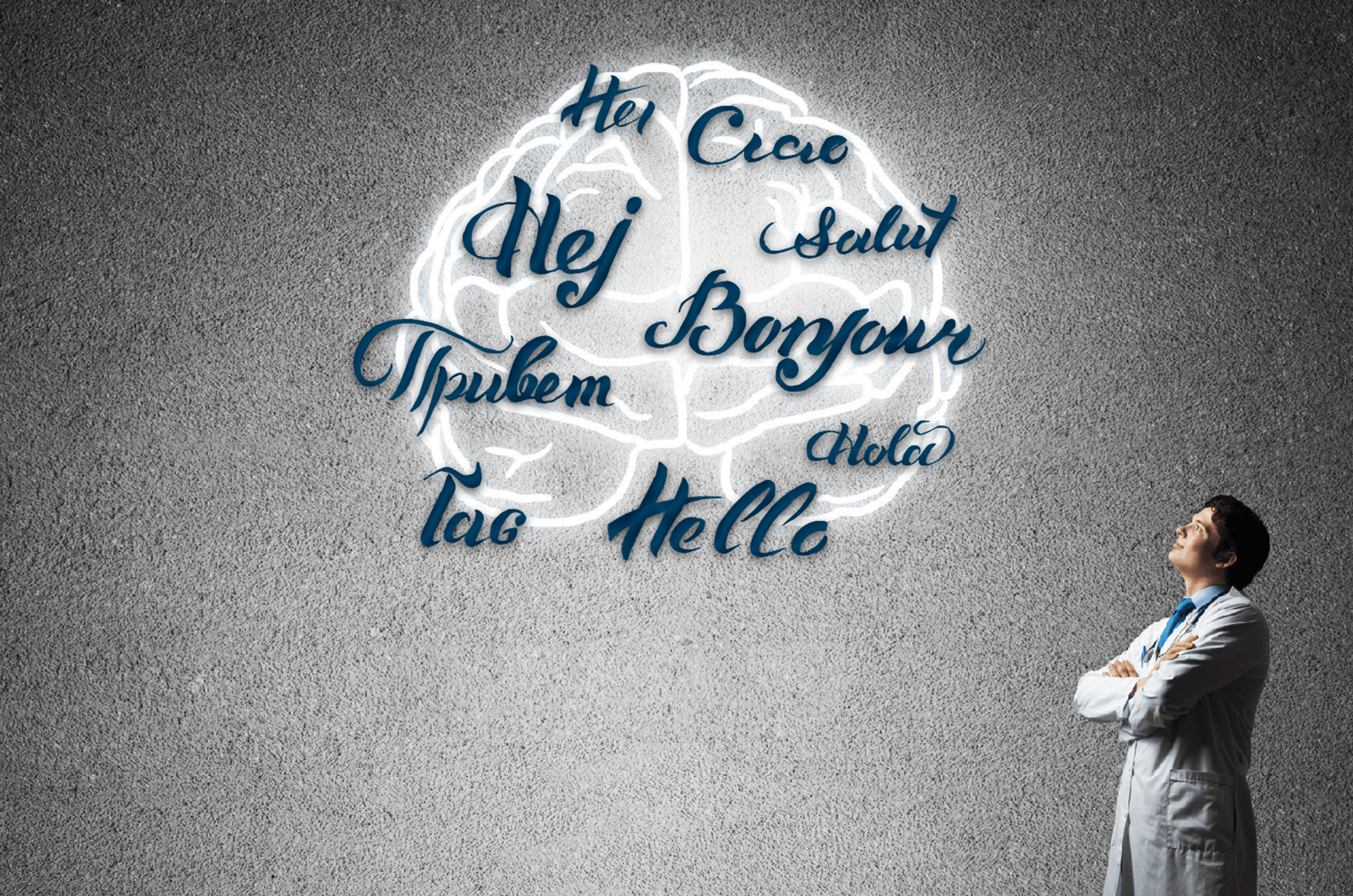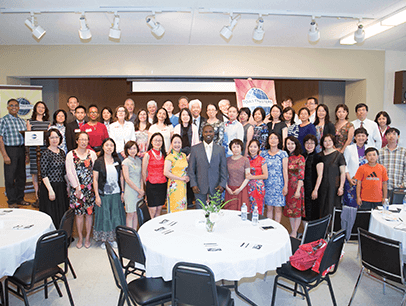
When Gabriella Szilvási, CC, joined Toastmasters, she wasn’t looking for a bilingual club. Saturday Toastmasters in Budapest, Hungary, just happened to fit her schedule. The fact that meetings were held in Hungarian and English was a bonus for the multilingual Szilvási, who is fluent in both languages, as well as German and Italian.
Szilvási’s native language is Hungarian. She started learning English at 9 and German at 14. She learned Italian as an adult. With each new language, she felt changes in her personality.
“It’s a completely different way of thinking,” she says. “When I speak in English, I’m very open. When speaking German, I’m more analytical. In Italian, I’m more emotional, and in Hungarian, I’m very critical,” she says. “When you’re able to communicate complex topics in a language, you’re getting into the emotion of that language.
“For example, the Hungarian alphabet has 44 letters. There are all kinds of tenses, and the personal pronouns are combined. The language itself is complicated, and that is symbolic of the Hungarian way of thinking.”
Szilvási finds it easier to express herself in English than Hungarian, and she wants to develop her skills in both. Like other bilingual Toastmasters clubs worldwide, Saturday Toastmasters provides that opportunity.
The club also provides an environment to put what she’s been learning into practice. As a trainer in neuro-linguistic programming—how our thinking and language combine to affect our bodies and behaviors—Szilvási is focused on language and how it affects thoughts and behaviors. She also knows that the effects of bilingualism can provide lifelong benefits.
Resilient Brains
Scientists have found that bilingualism rewires peoples’ brains. Research demonstrates that for people who are bilingual—defined in most studies as the ability to communicate in two languages, but not necessarily with a perfect command—both languages are active all the time. Therefore, bilinguals are constantly making selections between languages, which develops more connections inside the brain. Additional connections create an expanded network—like an increasingly intricate spider’s web—with more pathways for information to flow. As a result, the selection process for choosing words is more efficient and becomes easier.
Imaging studies, such as those conducted at York University in Toronto, Canada, and Pennsylvania State University in State College, Pennsylvania, have even shown that bilinguals are using different brain networks than monolinguals when making such language selections. “Bilinguals are using automatic networks that don’t require much energy because they’re selecting all the time. It’s easier for them,” says Dr. Ellen Bialystok, distinguished research professor of psychology at York University.
These selections happen in the prefrontal cortex, which is the front area of the brain just behind the forehead. It’s the site of the brain’s executive control for cognitive functions, such as planning, attention, problem-solving, decision-making and working memory.
“There isn’t a single study I’ve ever seen where there’s a bilingual disadvantage. There’s no downside.”
—Dr. Ellen BialystokThink of the prefrontal cortex as a reserve gas tank for the brain. When you need some extra gas, you can dip into your reserves. Bilinguals have more efficient networks—like more energy-efficient cars—so they require fewer resources. Monolinguals have to dip into reserves more often. “For most of life, that doesn’t make a real difference,” says Bialystok. “But later in life, when our resources begin to decline, and we become more reliant on the prefrontal regions, bilinguals have more resources left and have more resilience in those regions. They can keep functioning even if there’s a problem in their cognitive system.”
As an example, Bialystok conducted a neuroimaging study that confirms bilingualism postpones symptoms of dementia. While numbers vary, she and other researchers have demonstrated the delays can average four years or more. Scientists have also found that, in the early stages of Alzheimer’s disease, bilinguals maintain cognitive function within the normal range and show no symptoms of dementia; monolinguals in the same stage of the disease show symptoms.
“Don’t drop your native language. Speak it to your children. It’s the best present you can give to them.”
—Dr. Thomas BakStudies led by Dr. Thomas Bak, a cognitive neuroscientist and clinician at the University of Edinburgh in Scotland, indicate that bilinguals recover cognitive function after a stroke more than twice as often as monolinguals. While both have the same risk of developing aphasia—a disorder that interferes with a person’s ability to process and use language—monolinguals are more likely to have a more severe form of the condition.
Suzanne Holm, occupational therapist and professor at Regis University in Denver, Colorado, calls bilingualism a “cognitive enhancement.” When she was a practicing occupational therapist, she worked mainly with individuals after traumatic brain injury. “In working with our clients, we would want to know if they were bilingual, because then they would already have the cognitive reserve that could boost their recovery.”
Stronger Focus
Bilingualism also helps people pay attention to what’s relevant and focus when there’s a distraction. “It sounds like a trivial thing, but attention is the central aspect of cognition,” says Bialystok, a research professor in Toronto. “Attention develops early in infancy and matures throughout childhood. In older age, when we start to struggle with memory, attention is at the heart of everything significant of cognition.”
Bialystok was initially studying children and how they develop cognitively. “Dual language proficiency was leading to differences that I couldn’t explain by other means,” she says. She began to study bilingualism in children and later expanded that to adults. Now she’s looking at the lifecycle and what’s happening inside the brain.
Evolution of Research
Bilingualism research began in the late 1960s. For the first 20–30 years, most studies focused on children. More recently, scientists have shifted their focus to include the entire lifespan. In that time, our understanding of the brain has evolved. “We now have a much more dynamic understanding of the brain, its networks and connections,” says Bak. “Learning a language is all about brain connections.”
In fact, Bak found that you don’t have to be fluent in two languages to reap some of the brain benefits. In one study, he found measurable improved attention in people after just one week of language instruction. Those who practiced a new language five hours a week over nine months maintained the positive effects.
Steps for Brain Health
“I don’t know if the average person is thinking about building their cognitive capacity and reserve every day, but I wonder if we will start thinking in those ways,” says Holm. She cites increasing rates of Alzheimer’s disease and dementia, and the resulting difficulty people will have living alone and aging in place. As more are affected, Holm says that people may become more aware and informed about brain health and consider “specific actions they can take that will be cognitively enhancing or brain protecting.”
For Szilvási and the thousands of bilingual and multilingual Toastmasters, they are ahead of the game. And their Toastmasters experience is helping, as many use their different languages at bilingual clubs all around the world.
At least 5 percent of all Toastmasters clubs worldwide operate in more than one language. Some clubs alternate languages from meeting to meeting. Others allow different languages to be spoken during a meeting and sometimes even during a single presentation. Either way, bilingual club members are following some of the most important recommendations for brain health—practicing multiple languages, engaging in lifelong learning and staying mentally active.
“The active brain comes for free for all bilinguals,” says Bialystok. “There isn’t a single study I’ve ever seen where there’s a bilingual disadvantage. There’s no downside.” Bialystok, Bak and Holm all recommend staying engaged. They all also recommend teaching children more than one language, especially if parents speak two languages.
“Don’t drop your native language,” says Bak. “Speak it to your children. It’s the best present you can give them.” In fact, Bak notes that when bilingual or multilingual people become elderly, they often revert to their native language. Sometimes their children or grandchildren can’t speak the language and can’t communicate with them. He says, “It’s never too late to learn another language.” Good news for brains everywhere.
Jennifer L Blanck, DTM has more than 25 years of career development and advising experience. She is a member of 5-Star Toastmasters Club in Arlington, Virginia, and AAMC Toastmasters in Washington, D.C., as well as a regular contributor to the Toastmaster magazine. Learn more at jenniferlblanck.com



 Previous
Previous
 Previous Article
Previous Article

